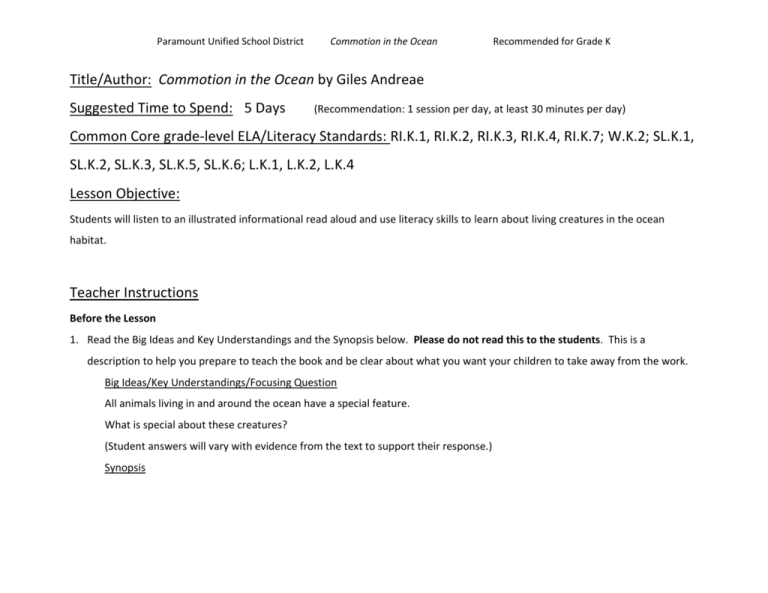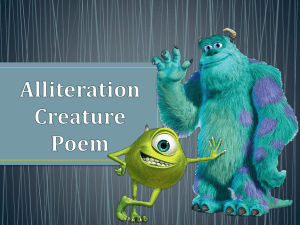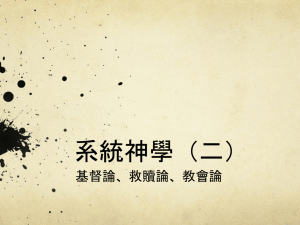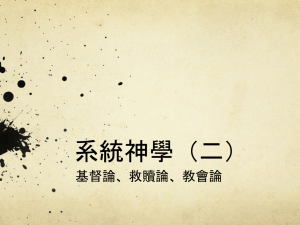Commotion in the Ocean
advertisement

Paramount Unified School District Commotion in the Ocean Recommended for Grade K Title/Author: Commotion in the Ocean by Giles Andreae Suggested Time to Spend: 5 Days (Recommendation: 1 session per day, at least 30 minutes per day) Common Core grade-level ELA/Literacy Standards: RI.K.1, RI.K.2, RI.K.3, RI.K.4, RI.K.7; W.K.2; SL.K.1, SL.K.2, SL.K.3, SL.K.5, SL.K.6; L.K.1, L.K.2, L.K.4 Lesson Objective: Students will listen to an illustrated informational read aloud and use literacy skills to learn about living creatures in the ocean habitat. Teacher Instructions Before the Lesson 1. Read the Big Ideas and Key Understandings and the Synopsis below. Please do not read this to the students. This is a description to help you prepare to teach the book and be clear about what you want your children to take away from the work. Big Ideas/Key Understandings/Focusing Question All animals living in and around the ocean have a special feature. What is special about these creatures? (Student answers will vary with evidence from the text to support their response.) Synopsis Paramount Unified School District Commotion in the Ocean Recommended for Grade K This is an illustrated collection of silly verses and rhymes that describe marine life creatures living in and around the ocean. It explores the undersea world by discovering what animals lie beneath. After an introductory poem, this informational picture book introduces children to 16 different ocean-going animals, including crabs, sharks, dolphins and polar bears. Go to the last page of the lesson and review “What Makes this Read-Aloud Complex.” This was created for you as part of the lesson and will give you guidance about what the lesson writers saw as the sources of complexity or key access points for this book. You will of course evaluate text complexity with your own students in mind, and make adjustments to the lesson pacing and even the suggested activities and questions. 2. Read the entire book, adding your own insights to the understandings identified. Also note the stopping points for the textinspired questions and activities. Hint: you may want to copy the questions vocabulary words and activities over onto sticky notes so they can be stuck to the right pages for each day’s questions and vocabulary work. The Lesson – Questions, Activities, and Tasks Questions/Activities/Vocabulary/Tasks FIRST READING: Define the vocabulary term commotion. Discuss the different types of commotion. Read aloud the entire book (or chapter) with minimal interruptions. Stop to provide word meanings or clarify only when you know the majority of your students will be confused. SECOND READING: Pages 1-8 The goal of this reading is to have students practice the vocabulary by using total physical response with body Expected Outcome or Response (for each) commotion-noisy disturbance visual commotion (crabs walking sideways, jelly fish jiggling) noisy commotion (dolphins squeaking) The goal here is for students to enjoy the book, both writing and pictures, and to experience it as a whole. This will give them some context and sense of completion before they dive into examining the parts of the book more carefully. Paramount Unified School District Commotion in the Ocean Recommended for Grade K movements and facial expressions. During this reading, the teacher should elaborate with gestures and voice to build vocabulary concepts. Reread page 2 (crab) QUESTIONS: What is the creature we’re talking about? What is special about this creature? What do you think the word sideways means? Reread page 3 (turtles) Provide definition of hatch and scamper QUESTIONS: What is the creature we’re talking about? What is special about this creature? What do you think bury means? How do you know? What did it state in the text? Reread page 5 (dolphins) QUESTIONS: What is the creature we’re talking about? What is special about this creature? What do you think squeak means? How do you know? What did it state in the text? What does the author mean that the dolphins are “trying to Crab This animal walks sideways. sideways-to walk from side to side Students act out the word sideways. Turtles The text says turtles bury their eggs on dry land. Turtles bury their eggs in the sand. They scamper. They hatch from eggs. hatch-to come out from the egg scamper-to run or go quickly Students act out the word scamper. bury -to place/put in the ground Dolphins Dolphins are trying to make a sound. Dolphins try to speak in a squeak. squeak-high pitched sound The text says “It’s more of a “Click-whistle-squeak!” Paramount Unified School District Commotion in the Ocean Recommended for Grade K speak?” Students make a squeaking noise. Reread page 7 (angelfish) QUESTIONS: What is the creature we’re talking about? What is special about this creature? Angelfish Angelfish are beautiful, gorgeous, and lovely. Reread page 8 (jellyfish) QUESTIONS: What is the creature we’re talking about? What is special about this creature? Define “jiggle”. Jellyfish Jellyfish jiggle. jiggle-to move up and down or to and fro with short quick jerks Students act out the word jiggle. ACTIVITY Choose 1 animal we discussed today and illustrate and write about how it is special. Create an anchor chart with words and drawings that will allow students to refer back to during multiple reads. Sentence frame: This is a _____. It is special because ______. What is the animal? crab THIRD READING: The goal of this reading is to have students practice the vocabulary by using total physical response with body movements and facial expressions. During this reading, the teacher should elaborate with gestures What is its distinctive feature? walks sideways Paramount Unified School District Commotion in the Ocean Recommended for Grade K and voice to build vocabulary concepts. Reread page 9 (shark) QUESTIONS: What is the creature we’re talking about? What is special about this creature? Why does the shark ask you to come in closer? Define vocabulary word grin. Shark A shark has jaws that open wide. The shark wants to eat you. grin-a broad smile Students show how they can grin. Reread page 10 (swordfish) QUESTIONS: What is the creature we’re talking about? What is special about this creature? What does the swordfish mean when he says “he’ll skewer a few with his sword?” Does he really have a sword? Define vocabulary word skewer. Swordfish A swordfish has a long sword-like nose that can skewer other animals. skewer-a long, sharp pin used for holding food together Students are shown an example of something being skewered. Reread page 12 (octopus) QUESTIONS: What is the creature we’re talking about? What is special about this creature? Octopus An octopus has eight arms. Reread page 13 (stingray) QUESTIONS: What is the creature we’re talking about? What is special about this creature? Does a stingray really have wings? What does the author mean when it says that the stingray Stingray A stingray has a tail that can sting and fins that help them glide through the water. No, a stingray has pectoral fins that resemble wings (i.e., Paramount Unified School District Commotion in the Ocean “flaps its wings?” How does the illustration support the text? Reread page 14 (lobster) QUESTIONS: What is the creature we’re talking about? What is special about this creature? Why shouldn’t we shake hands with a lobster? How does the illustration support the text? What does snip and wise mean? ACTIVITY Choose 1 animal we discussed today and illustrate and write about how it is special. Recommended for Grade K airplane & birds). A stingray moves its fins. The illustration shows the tail can sting something and the stingray can glide like an airplane. Lobster A lobster has claws that can snip all your fingers in two. A lobster has claws that can snip you fingers in two. The illustration shows the lobster claw. snip-to cut or clip with quick strokes wise-having a lot of knowledge about something Sentence frame: This is a _____. It is special because ______. Continue anchor chart with words and drawings that will allow students to refer back to during multiple reads. What is the animal? lobster FOURTH AND BEYOND: The goal of this reading is to have students practice the vocabulary by using total physical response with body movements and facial expressions. During this reading, the teacher should elaborate with gestures and voice to build vocabulary concepts. What is its distinctive feature? can snip with its claws Paramount Unified School District Reread page 16 (Deep Sea Creatures) QUESTIONS: What are the characteristics of a deep-sea creature? Reread page 17 (Blue Whale) What is the creature we’re talking about? What is special about this creature? What do you think massive means? Define cling and barnacle. How does the illustration support the text? Commotion in the Ocean Recommended for Grade K Teacher writes down notes using a graphic organizer. Deep Sea Creatures Characteristics Every shape and size Giant pointed teeth Lives far below the surface Bulging eyes fish Walk around on the ocean floor Balance on their fins Glowing whiskers on their chins Blue Whale A whale is huge and it has barnacles that cling to the bottom the bottom. Students use text to respond with the synonyms for massivebig, giant, huge, etc. The text states the whale is 100 feet long. cling-to stick to or to hold on tight barnacle-a marine animal that clings to the bottom of ships and animals. The illustration shows that the whale is huge and barnacles are clinging to the bottom of the whale. Paramount Unified School District Commotion in the Ocean Reread page 19 (Walruses) QUESTIONS: What is the creature we’re talking about? What is special about this creature? Define blubber, tusks, and bellow. Reread page 21 (penguins) QUESTIONS: What is the creature we’re talking about? What is special about this creature? Define waddle, slither, iceberg. Reread page 22 (Polar Bears) Show students on a map where the Arctic is located. QUESTIONS: What is the creature we’re talking about? What is special about this creature? ACTIVITY Choose 1 animal we discussed today and illustrate and write about how it is special. Recommended for Grade K Walrus A walrus’ have incredibly long tusks, they can bellow out loud to show they are mighty and strong, they have blubber to keep them warm in the cold ocean. blubber-the fat layer between skin and muscle tusks-point out illustration, make connection to elephant’s tusks bellow-to roar, a loud cry Students bellow loudly. Penguin Penguins can waddle around icebergs. waddle-to walk with short steps, rocking from side to side slither-to slide down or along a surface iceberg-point out illustration Students act out waddle, slither, and slide. Polar Bears Polar Bears live in the Arctic and it is very cold out there. Sentence frame: This is a _____. It is special because ______. Paramount Unified School District Commotion in the Ocean Continue anchor chart with words and drawings that will allow students to refer back to during multiple reads. What is the animal? Polar bears Recommended for Grade K What is it’s distinctive feature? Live in the Arctic FINAL DAY WITH THE BOOK - Culminating Task Students use the graphic organizers they have created throughout the close reading of this book (days 2 – 4) to help them create an explanatory/informative book with illustrations about the special features of creatures living in the ocean. Students should include 3-5 sea animals with details about each of them using vocabulary words from the text. Topic Sentence: There are many creatures living in the sea. Sentence Frame: A _____ is special because ______. Paramount Unified School District Commotion in the Ocean Recommended for Grade K Vocabulary These words merit less time and attention p. 5 squeak-high pitched sound p. 8 jiggle-to move up and down or to and fro with short quick jerks p. 9 grin-a broad smile p. 10 skewer-a long, sharp pin used for holding food together p. 14 snip-to cut or clip with quick strokes p. 17 cling-to stick to or to hold on tight p. 17 barnacle-a marine animal that clings to the bottom of ships and animals. p. 19 blubber-the fat layer between skin and muscle p. 19 tusks-point out illustration, make connection to elephant’s tusks p. 19 bellow-to roar, a loud cry p. 21 waddle-to walk with short steps, rocking from side to side p. 21 slither-to slide down or along a surface p. 21 iceberg-a large piece of ice broken off from a glacier floating in open water These words merit more time and attention p. 1 commotion-noisy disturbance p. 2 sideways-to walk from side to side p. 3 hatch-to come out from the egg p. 3 scamper-to run or go quickly p. 3 bury -to place/put in the ground p. 14 wise-having a lot of knowledge about something p. 17 massive-big, giant, huge, etc. Paramount Unified School District Commotion in the Ocean Recommended for Grade K Fun Extension Activities for this book and other useful Resources 1. Crayon Resist Watercolor Painting Students draw an ocean habitat of the different sea creatures discussed in the story using crayons. Then, using watercolors, student paint over the ocean scene. 2. Kids.nationalgeographic.com Students can read and watch videos about many different marine animals in their habitat. 3. neok12.com Students can view short videos of various ocean animals. 4. monteraybayaquarium.org Students can read about what it takes to care for sea animals in the aquarium. Students can research the different sea creatures with tentacles. 5. For an additional focus in Commotion in the Ocean, reread in its entirety. Focus students’ attention on the point of view of the author. The author uses 3rd person and 1st person to tell about the ocean animals. Teacher can draw attention to the text structure (e.g. headings in the story and the variation of the font color on page 14). Paramount Unified School District Commotion in the Ocean Recommended for Grade K What Makes This Read-Aloud Complex? 1. Quantitative Measure Go to http://www.lexile.com/ and enter the title of your read-aloud in the Quick Book Search in the upper right of home page. Most texts will have a Lexile measure in this database. Most of the texts that we read aloud in K-2 should be in the 2-3 or 4-5 band, more complex than the students can read themselves. 2-3 band 420-820L 4-5 band 740-1010L 850L 2. Qualitative Features Consider the four dimensions of text complexity below. For each dimension *, note specific examples from the text that make it more or less complex. This informational text is an introduction to ocean animals and factual information about living creatures in the ocean habitat. Focus student’s attention on point of view of the author. The author uses 3rd person and 1st person to tell about the ocean animals. Teacher can draw attention to the text structure (e.g. headings in the story and the variation of the font color on page 14). The poem is written in silly rhyming verses. Meaning/Purpose Rhymes, rich vocabulary, scientific Language Structure Knowledge Demands vocabulary, descriptive words. Some students may need background on how crabs walk sideways and about lobster claws. 3. Reader and Task Considerations What will challenge my students most in this text? What supports can I provide? The vocabulary will be the most challenging. Support systems will include acting it out, repeated readings, and bringing realia (i.e., pictures of animals, skewers). How will this text help my students build knowledge about the world? Students will gain knowledge about ocean habitats and its living creatures. 4. Grade level What grade does this book best belong in? Kindergarten. Students need to hear and use a lot of vocabulary. They are learning to about the special features of ocean creatures.






